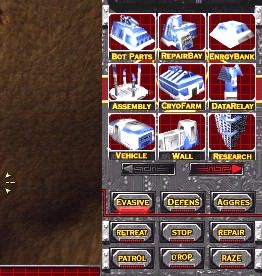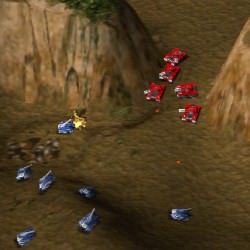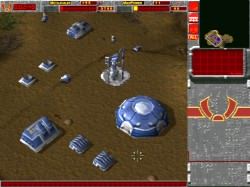| Metal Fatigue Interview
Courtesy of Psygnosis |
||||
|
Responses by: Jason Hough, Game Designer on Metal Fatigue Q: How distinctive are the different physical settings of the battles? Is the environment alterable/morphable in response to player actions? From a graphical standpoint we have four very rich and different looks for our landscapes. Some are more organic than others, which provide for different map layouts that can change your strategy. The Underground layer on every map is alterable in the sense that you can drill out caverns and passageways. Q: What kind of penalties will players encounter if they go into Metal Fatigue with a "blast everything in sight" mentality? Will they literally be forced to change their ways to succeed in the game? That's actually a very difficult question to answer. It really depends on the mission and the strategy of their opponent. As I mentioned before, each side has a unique set of Combot parts to use, and because you can lop them off and put them on your own Combots, we've really tried to encourage that people get out there and fight. If you mindlessly destroy the enemy, say, without using amputation weapons, then you may be limiting your opportunities to get enemy technology. Although there is technology advancement within your own suite of parts as a game progresses, the real reward comes when you successfully retrieve a part from battle and then use it against your enemy. It's very satisfying! That being said, it's also important to try and form balanced squads of units. Using stuff like tanks or missile cars as support vehicles for your Combots, or pairing up a hand-to-hand oriented Combot with one that's using all ranged weapons, is definitely to your advantage. Running around with a lone super deluxe Combot is a dangerous and expensive strategy. But, it can work under certain circumstances.
 GUI up close. Q: What special design or gameplay challenges has your combination of indoor and outdoor environments created? Does gameplay really move seamlessly between the two, or do you experience an awkward pause or break in the action? It was very important to us when developing the Metal Fatigue engine to ensure that there was no pause in changing between the layers (I assume that's what you mean by indoor and outdoor - it's really surface, underground, and orbit). Changing layers happens in the blink of an eye. Indeed, we actually considered adding a pause to help reinforce that a layer change was occurring. The challenge for us was making the management of three layers easy for the player. We were worried that it would be overwhelming, as if you were playing three games at once, but could only see them one at a time. We had two conceptual breakthroughs on this topic. First, we realized that in any RTS game, at any given time you're only looking at a fraction of the playfield anyway. That is, in all these games the main viewport only shows part of the map and action is happening off screen all the time! That meant we could think of our three layers as one big map broken into three sections. Second, the primary thing the player cares about is whether a battle is occurring off screen. Once we realized this, the design solutions were straightforward. We let the player toggle the mini-map so it shows all three layer maps instead of one, have battle indicators on the mini-map AND on the toolbar. The toolbar battle indicator flashes when battles occur on another layer, and most important, have audio cues like, "Battle in orbit" so the player doesn't even need to look at the mini-map to know a battle is occurring somewhere. We also wanted to make sure that each layer has differences from the others, and provides different strategic elements to the game. So far it's worked out well. Playing on three layers, after a few games, seems almost second nature, and really makes the game feel a little more frantic and fast-paced than other RTS games. You never really feel like you're just sitting there waiting for something to finish building, instead you start building something on one layer, then maybe go underground and tunnel around looking for resources while you wait. |
 Q: What is your own personal favorite element of Metal Fatigue? Being able to lop off the arm of an enemy Combot, then actually put it on your own Combot and attack him with it. My personal favorite game moment so far was when my herocrew's Combot was being chased down by the AI, and the AI was gaining fast, so in a panic I ejected both of the Combot's arms so that I could run faster. It worked even better than I expected, as the AI suddenly stopped altogether to pick up the valuable arm's I'd left behind.
 Q: What is the experience of the developer Zono in developing games of this type on the PC platform? How are Zono and Psygnosis cooperating in the design and execution of the game? Who is responsible for what? Our prior experience developing PC games is jack squat! Seriously, up till Metal Fatigue, we were a console developer. In our mind, the PC is just another hardware platform. The transition wasn't so difficult since we've always used PC's as our development hardware and wrote all our tools on the PC too. I think having experience on a platform is helpful, but not as important as having good, strong game development skills (regardless of platform) and most of all a passion for the game you're making. On product development issues we work pretty closely with Steve Patterson, our Psygnosis producer. Steve's a fan of RTS games, so his perspective on design issues is extremely valuable. Although Zono is responsible for design and execution, our relationship with Steve is close enough that we think of him as one of the team members. In this industry, the relationship between developer and producer/publisher isn't always as strong, so we consider ourselves pretty lucky. And we're not just saying that because he'll read this! We also get excellent feedback from Psygnosis Test on game play issues. RTS games are notoriously hard to tune and balance, so getting lots of people to play the game and give feedback is a big plus. Q: How close are you to completing the game? What remains to be done? We're approaching Alpha. We have the standard miscellaneous bugs, always looking for any further optimizations, looking to maximize card capability for older cards, putting the finishing touches on the AI, and of course play balancing/tuning. That's the biggie - tuning an RTS game is so crucial to making it fun and we'll be doing it right up until we ship the game. Q: Do you anticipate creating sequels to Metal Fatigue? Do you plan to use the game engine in any other projects? We've thought a little about sequels and mission packs, but we're pretty busy right now and don't want to get distracted from making Metal Fatigue as good as possible. We may use some parts of the engine for other projects, but again, we've gotta finish this one first! Join a discussion forum on this article by clicking HERE.
|
|||
|
Copyright © 1997 - 2000 COMBATSIM.COM, INC. All Rights Reserved. Last Updated June 23rd, 1999 |
||||
